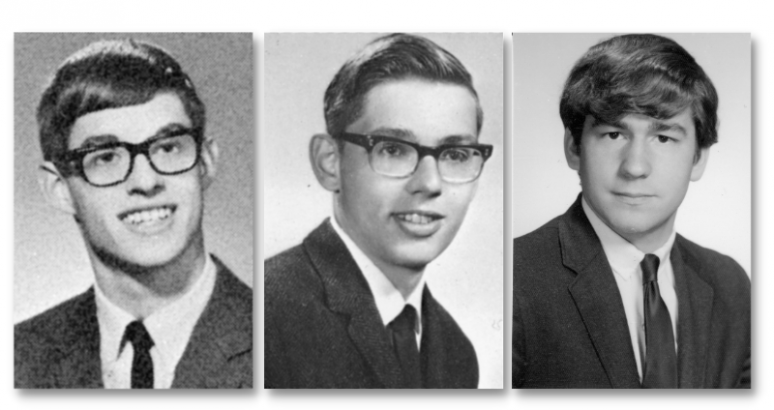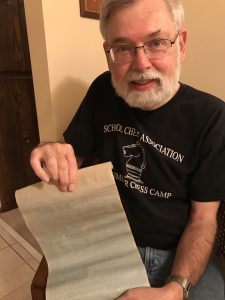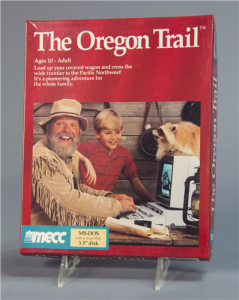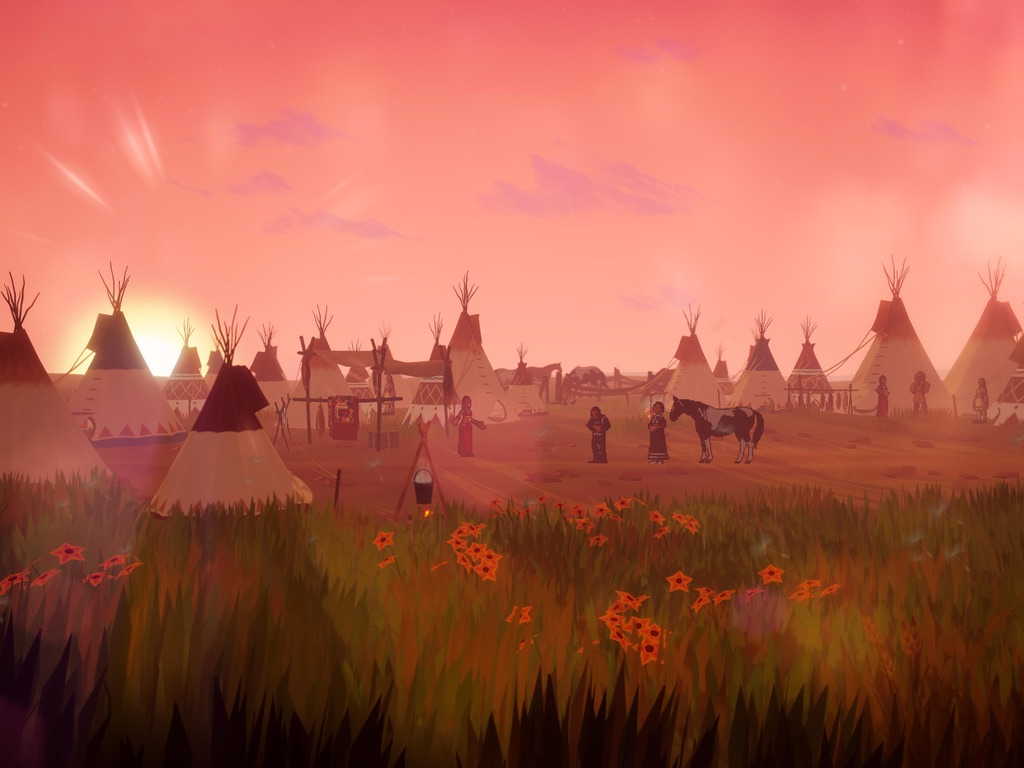‘Oregon Trail’ at 50: How Three Teachers Created the Computer Game That Inspired — and Diverted — Generations of Students
By Greg Toppo | December 2, 2021
In 1971, a trio of Minneapolis educators, using a hulking teletype machine connected to a mainframe miles away, designed the legendary game of westward expansion (and dysentery) that would help revolutionize personal computing. Despite more than 65 million copies sold, they never saw a dime.
Do you want to eat (1) poorly (2) moderately or (3) well?
A long, long time ago in Minneapolis, this question loomed over a small group of eighth-graders.
Appearing on a teletype machine — basically a primitive computer keyboard connected to a printer — at Jordan Junior High School, the strange question broke open the world of The Oregon Trail. Decades later, the title remains perhaps the most influential educational video game ever created, one that endures today as its influence is still being felt across the gaming industry.
Here’s the thing: If you thought the first kids to play this game were millennials in the 1990s, or even Gen Xers back in the 1980s, think again. The first students to experience The Oregon Trail were Baby Boomers, born in the late 1950s and now old enough to be grandparents.
The date: Dec. 3, 1971.

The Oregon Trail is that rarest of artifacts, a computer game that predates the rise of the personal computer by about five years — even the first rudimentary video arcade and TV computer games were still a year off. Built by an unlikely trio of undergraduate teaching candidates, its first young players encountered it on a paper roll fed into a hulking teletype, connected by a phone line to a mainframe computer miles away. There were no pictures or graphics, only lines of type and the occasional ringing bell.
It was mesmerizing.
Don Rawitsch, then 21 and a student-teacher at Jordan, had developed it originally as a dice-and-card game, laid out on a long butcher paper map. He’d been assigned to teach an eighth-grade history unit on westward expansion, and he wanted to do something new and interactive. Then, one evening just before Thanksgiving, one of his roommates came home, saw what Rawitsch was doing, and envisioned something completely different.
“I saw this map on the floor and I said, ‘Oh, this looks interesting,’” said Bill Heinemann, then teaching math across town. The pair, along with three other roommates, were all just months away from graduation at Carleton College in Northfield, Minn., about 40 minutes south. Heinemann had taken a few programming classes and played some basic simulation games — Civil War logistics and lunar landers among them.
“There wasn’t much out there that was very fun,” he recalled.
Then he saw Rawitsch’s map, telling him, “Oh, this would be a perfect application for a computer.” He showed the map to another roommate, Paul Dillenberger, who was also teaching math. Dillenberger liked the idea and signed on as Heinemann’s debugger.
Rawitsch was delighted. He told them he needed it in 10 days.

Thus began a mad dash to code the game in BASIC at a teletype at Bryant Junior High, where Heinemann and Dillenberger taught. The unit sat in an anteroom to the janitor’s closet, where there was space for just the teletype and one extra chair.
Over a week and a half, the trio laid out a basic narrative in which players loaded up a covered wagon with food and supplies and lit out from Independence, Mo., in April 1848, for Oregon’s Willamette Valley. Day by day, unforeseen difficulties arose such as illness, bandits, and bad weather, and players tried their hands at a selection of mini-games asking them to hunt and ford rivers. Players won by making it all the way to western Oregon with at least a few members of their party still alive.
The trio also programmed a few surprises to keep players on their toes.
“I wanted to make it so that it was fun, and I wanted to make it so that it was worth playing again,” Heinemann recalled. So he had the game generate “enough random things” along the trail such that playing even a dozen times brought something new and unexpected.
He programmed the game to randomly hand players an assortment of snake bites, wild animal attacks and broken wagon wheels. They’d occasionally get lost in the fog. And, of course, they’d sometimes succumb to disease — over the decades, “You have died of dysentery,” added in a subsequent version, became the game’s defining meme.

On Dec. 3, Rawitsch dialed the number to the district’s mainframe, snuggled a telephone receiver into place, and began moving groups of students through the game’s paces.
It was an instant hit. Students came to Rawitsch, asking if they could play before or after class. Lines would form down the hall each morning as students waited for a chance to try again. For many, it was the first time they’d sat down in front of anything even resembling a computer.
Because Rawitsch was able to reserve the teletype for just a week, he had to think creatively. So instead of letting students play individually, he had to combine them into groups of four or five. That turned out to make the game more compelling.

“They’d use this as an opportunity to do some group problem-solving,” he said, recalling arguments about who exactly did what in the game. “After a while, when they figured out that their time in class was going to run out if they kept wasting time arguing over decisions, somebody said, ‘Well, why don’t we vote on it?’ So they kind of created democracy on the fly.”
Each democracy also functioned as a meritocracy — the hunting mini-games required players to type words like BANG or BLAM as quickly and accurately as possible. Kids recruited the best typist in the group.
At the end of the week, Rawitsch had to relinquish the teletype, rolling it into a colleague’s classroom. The experiment came to an end, and the trio prepared to wrap up their work in the two schools. But before they did, they printed out a few copies of the 800 or so lines of code, tore off the three-foot scrolls and took them home.
‘Trailheads’
The five-day stretch of play at Jordan Junior High that December might have been the end of The Oregon Trail. But in 1974, Rawitsch took a job at a new nonprofit called the Minnesota Educational Computing Consortium (MECC), which sought to bring access to educational software to schools statewide.
By the early 1970s, Minnesota was a proto-Silicon Valley, with four of the U.S.’s biggest computing companies — UNIVAC, Control Data, Honeywell and IBM Rochester — setting up shop there in the years before the California-born personal computer took over in the popular imagination. And while most schools at the time looked upon computers simply as tools to, well, teach about programming more computers, MECC’s founders took a broader view, creating a library of instructional software on a variety of topics that any school statewide could use for free. When his bosses put out a call for innovative products, Rawitsch volunteered to find the paper roll and type out the code, and soon the game was available to anyone with a link to the state consortium’s mainframe.
Teachers began taking notice. The game quickly became MECC’s most popular title. As desktop computers began to sprout in classrooms, MECC spun off a for-profit company that sold millions of copies of The Oregon Trail and other early titles nationwide.
A new generation of coders added graphics, sounds, and music to create the versions of The Oregon Trail that most kids have played since. By then, Rawitsch had moved on, but in 1995, a decade after the game first appeared on Apple II computers, MECC President Dale LaFrenz told an interviewer that The Oregon Trail accounted for about one-third of MECC’s $30 million in annual revenue. One estimate has put the total number of copies sold at more than 65 million.
Because they gave the game to the consortium in 1974 without any expectation of being repaid, the original creators never saw a dime. Actually, they weren’t even widely recognized as its creators until 1994, when MECC brought them together for a celebration of the game at the Mall of America. After MECC handed each of them “Trailheads” jackets — a play on Deadheads — Dillenberger joked to a reporter, “I got a jean jacket and a copy of the game instead of owning an island somewhere.”

In interviews, none of the three — by now all hovering around retirement from careers in teaching and tech — expresses any bitterness about the way things turned out. If not for MECC, Rawitsch said, the original game would have had no home at all, with no way to convert it a few years later from mainframe to PCs. The consortium’s subscription system also made it possible for the game to find fans among students and teachers nationwide in the 1980s and 1990s.
“I feel pretty proud of what we accomplished and how many people we reached,” said Dillenberger. Since MECC feted them at the mall, “We’ve been on TV, we’ve been in articles and podcasts. It’s kind of constant,” Dillenberger said. “I’ve got two other people trying to get a hold of me right now.” Loyal fans have created a reproduction of an early Macintosh-compatible version that’s playable today.
Eventually the state sold MECC to an investment group that was bought by a larger group. The intellectual property of MECC — by now no longer a consortium but a corporation — soon became part of a failed acquisition involving the toy company Mattel. Had it been successful, we might have actually seen Barbie traversing the Oregon Trail. The move was so ill-conceived that it earned a chapter in a 2005 business book on mergers and acquisitions titled Deals from Hell.
Not the first edu-game
The Oregon Trail didn’t actually represent the first known use of a computer simulation in school. That honor goes to a group of IBM programmers and teachers in Westchester County, N.Y., who in the mid-1960s developed The Sumerian Game, a sort of Dungeons and Dragons in the Fertile Crescent, said Jon-Paul Dyson, director of the International Center for the History of Electronic Games at the Strong Museum of Play in Rochester, N.Y.
But The Oregon Trail stands out for being sensitive to its players — many of Rawitsch’s students were Native American, and the designers were aware of that. “One of the things that the game doesn’t do, for instance, is have the pioneers fighting Indians,” Dyson said. “It would’ve been very highly likely that a game in the ’70s would have that. But in fact, the interactions with Indians and Native Americans in there, it’s generally about providing food or that sort of thing.”
The latest version, developed for mobile devices by the firm Gameloft, goes further, promising “respectful representation” of Native characters, with playable stories “celebrating the history and cultures of the peoples who first lived on this land and still live here today.”

At its heart, Dyson said, The Oregon Trail stands out for a simpler reason: “It’s a good game.”
It mixes resource management with an engaging “hero’s journey” narrative. “The game is very well balanced,” he said. That has helped it endure for so long — players can download the latest version in one of 14 languages.
For these reasons, it’s in the Strong’s World Video Game Hall of Fame, one of only 32 games so honored and one of just two education-related games.
‘You often died, which is kind of fun’
In some ways, The Oregon Trail had perfect timing, appearing on personal computers just as they were beginning to colonize suburban desktops and classrooms.
Gary Goldberger, president and co-founder of FableVision Studios, a Boston-based learning games company, remembered growing up in the suburbs of Rockland County, north of New York City, as computers began appearing. The Oregon Trail may have been a one-player game, but he and his friends “just played it as a collective …. We would always do group decision-making, which is kind of the model that I like in general. It’s something we put into our games: How do we get people to talk outside of the game? And how do we have collaboration?”
He and his friends never actually thought of The Oregon Trail as an educational game. “We just thought of it as a game that we were playing, which is like the best of what we always try to achieve,” he said.

Starting with the BANG-generated hunting, the game basically invented the mini-game, a quick challenge within the larger one that’s still used in the biggest-budget commercial video titles, such as Assassin’s Creed, which tasks players with becoming a locksmith, among other things. At a more basic level, Goldberger said, the game put players in charge of their own fate — and wasn’t afraid to kill them to show that the frontier was unforgiving. “You often died, which is kind of fun also.”
From spectator to subject
At its most basic, the game helps teachers confront one of the biggest challenges in teaching history, said Paul Darvasi, a longtime Toronto high school teacher: Students “have a very difficult time embodying the past,” he said. But a good game like The Oregon Trail makes that happen immediately by dropping players into situations where their decisions matter.
“What’s really interesting is that obviously when you are making decisions, you are deviating from historical realities, because history is set and done,” he said. But in making that leap, players immediately begin to understand why historical figures made the decisions they made. “It actually helps cultivate a historical mindset,” he said, because players are wondering about subjects’ motives: “Why did they want to go out west? Why would they want to suffer? Why did they make these decisions? Why did they cross the river and not take a bridge?”
Darvasi has become well-known for using immersive simulations — he used to teach One Flew Over the Cuckoo’s Nest by dressing up as a fearsome nurse and turning his classroom into a mental ward for a month. He said a game like The Oregon Trail can similarly “micro-target” students with content that sticks. “It’s a counterpoint to these massive historical surveys that we do: The History of the Roman Empire, 700 Years in Three Classes,” Darvasi said.
Fifty years later, starstruck fans feel the need to tell Rawitsch, Heinemann and Dillenberger how much the game meant to them as kids. Dillenberger, its original debugger, said autograph seekers still find him and say, “‘You really saved my life in middle school because of this program.’ It’s just incredible how many people we touched.”
Lead Image: Screenshot from “The Oregon Trail” (Meghan Gallagher for The 74)
Get stories like these delivered straight to your inbox. Sign up for The 74 Newsletter


